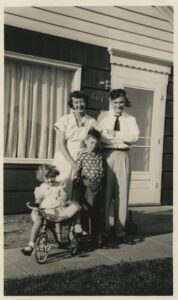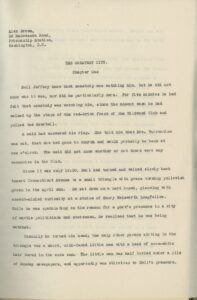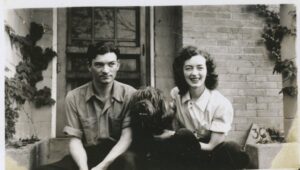calsfoundation@cals.org
Letters, Diaries, Photos, and More Added to the Dee Brown Papers
This year, the CALS Butler Center for Arkansas Studies processed an addition of forty-four boxes of material for the Dee Brown papers. This additional material includes personal items from the lives of Arkansas author Dee Brown, his wife Sally, their children Mitch and Linda, and other family members. Letters to or from Dee and Sally, as well as other family members, span the years 1904 through 2007. Dee Brown’s diaries from 1944 through 1998 and Sally Brown’s diaries from 1929 through 1977 are also included, as are more than 500 photographs from the lives of the Brown family.

Dorris Alexander (Dee) Brown was born in Louisiana on February 29, 1908. Brown’s father, Daniel Brown, died in 1912 and the family moved to Arkansas, first to Stephens in Ouachita County and later to Little Rock; Brown graduated from Little Rock High School in 1927 and from Arkansas State Teachers College (now the University of Central Arkansas) in Conway in 1931. An aspiring author since his youngest days, he moved to Washington DC where he attended George Washington University and then began working at the U.S. Department of Agriculture Library. He married another ambitious writer from Arkansas, Sarah “Sally” Stroud, in Washington on August 7, 1934. They would have two children, James Mitchell “Mitch” Brown and Linda Brown.

Along with the letters, diaries, and photographs, the material added to the Dee Brown papers also includes short stories, poems, and essays from both Dee and Sally. Dee’s final draft of his first novel, The Greatest City, presented a humorous look at New Deal bureaucracy. The novel was set for publication in 1941, but the entry of the United States into World War II persuaded the publisher that the American public wanted more-patriotic reading material. As a result, the novel was never published. Dee went on to write both fiction and nonfiction about the American frontier, beginning with a book about his distant relative Davy Crockett. He was called to service in the U.S. Army (which he documented with letters to Sally, photographs, and some short stories and essays); after the war, he was hired by the University of Illinois in Urbana-Champaign, where he worked until his retirement in 1973. Dee and Sally then moved to Little Rock, where he continued his writing career.
Dee Brown’s greatest fame came from a nonfiction work published in 1970. Bury My Heart at Wounded Knee: An Indian History of the American West, succeeded far beyond the expectation of Brown or his publishers. Brown became friends with American Indians in Stephens and in Little Rock, and his research for earlier books and papers had opened his eyes to many rarely used sources about the expansion of the United States into the central and western portions of North America. Coming at a time of national self-examination in the midst of the civil rights movement and the Vietnam War, the book was seen as a shocking revelation of American atrocities against Native American tribes and cultures. Containing many primary sources, including government reports and oral histories, Bury My Heart presents a thorough and multifaceted approach to the cultural conflict. Flagrantly racist attitudes, hostility, and brutality are shown from both sides of the struggle, as well as mistakes based upon misunderstandings and cultural differences. Changing attitudes are shown by some historical figures, both white American and American Indian, as events forced individuals to reassess their opponents. Clearly, the greater losses happened to the Indians of the plains and the western coast. Yet Brown’s work transcends diatribe and condemnation to offer a balanced portrayal of an important cultural confrontation.

Beyond Dee Brown’s published works, many other interesting stories can be found in the Brown family records. Sally emerges as a vibrant and unique personality, even though the fame of authorship did not come to her as it came to her husband. Her exchange of letters with author Robb White tells a fascinating story, as do her responses from other celebrities to whom she wrote over the years. Brown’s response to the success of his one book, and his tireless efforts to share other stories over the years, presents a side of writing often left unseen. (Brown frequently commented that the timing of Bury My Heart was a blessing to him; earlier success as an author would have ruined him, he said.)
Photographs of Mitch’s time as a soldier in Vietnam, snapshots of the Brown family on vacation, and reflections on experiences and events in their most personal writings open a new vista for the observer of one Arkansas author’s life.
Read more on the CALS Encyclopedia of Arkansas about Dee Brown here. And view the finding aid for the entirety of the Dee Brown papers here.
To view items from the collection, visit the Research Room at the CALS Roberts Library. Visiting information can be found here.
By Steve Teske, archivist at the CALS Butler Center for Arkansas Studies/Roberts Library




